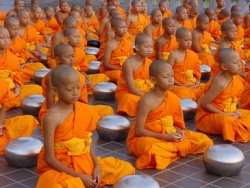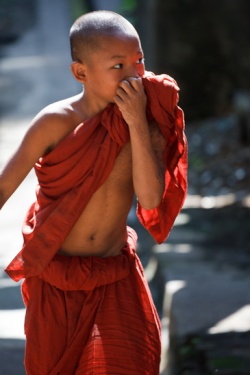The Significance of the Kaṭhina Robe Offering Ceremony
Buddhistdoor International Venerable BD Dipananda 2013-10-31
The three-month rains-retreat seclusion of Buddhist Saṅgha concludes with the pavāraṇā (invitation) ceremony, which is in turn followed by Kaṭhina robe offering festival. It is a traditional ceremony and ancient custom mostly found in the Theravada Buddhist tradition. Today, the Kaṭhina robe offering is a large, annual festival where Buddhists get together and celebrate the day by offering monastics gifts, such as robes and alms.
Kaṭhina means “hard”, “stiff”, “difficult”, etc. The word Kaṭhina denotes a cloth offered to the monks annually after the end of the rains-retreat (vassāvāsa). It also refers to a wooden frame used by the monks in sewing their robes. However, the word mostly denotes the robe, cīvara in pali, known as Kaṭhina cīvara. The character of the material used symbolizes the cīvara, which is one of the four requisites of a monk. The Kaṭhina robe is offered to the monastic Saṅgha by lay followers. Apart from the lay followers, monks, nuns and novices also can offer to the Buddhist Saṅgha.
The historical background of the Kaṭhina robe offering is mentioned in the Vinaya Pitaka. While the Buddha was dwelling at Jetavana Vihara in Shravasti, a group of thirty monks visited the Buddha after the three-month rains-retreat. The Buddha asked them about their retreat and noticed their worn out robes. It is said that at the time, monks used to wear sewn pieces of cloth collected from different places such as cemeteries, streets, rubbish-heaps, etc.To rectify this, the Buddha granted permission to celebrate the Kaṭhina ceremony with the following such rules:
- Only those who have successfully completed the rains-retreat can accept the Kaṭhina robe.
- The period of the offering is only one month, from the middle of September-October to October-November (lunar month), and contemporary Assayuja to Kattikā (full moon of the Buddhist month).
- When the Kaṭhina robe is offered to the Buddhist Saṅgha by lay followers, a group of monks (not less than four monks) will officially hand over to a selected monk by performing some Buddhist ritual activities (Vinaya rules).
- A monk who has received the Kaṭhina robe, is not allowed to receive the Kaṭhina robe a second time in the same month period.
- Whoever observes rains-retreat from the later (pacchimikā) time, also not allowed to receive the Kaṭhina robe. Only those who have entered the rains-retreat from the earlier (purimikā) time, are allowed to receive it.
The proper time to give the Kaṭhina robe is from sunrise to dawn the next day, and in modern time it is calculated as twenty-four hours.
The monk who accepts the Kaṭhina robe enjoys five privileges. From the date of the ceremony, (i) he is free to go to a meal invitation without having informed another monk. (ii) Usually monks use a full set of three robes, but he is allowed to go without taking a full set robes according to a specific period of time without any fault. (iii) He can enjoy a group meal (with four or more monks). (iv) He can use as many as robes as he likes (v). Finally, he can receive other robes offered to the Buddhist Saṅgha during the period of rainy season and on the occasion of the Kaṭhina ceremony.
The Buddha himself stated the significance of the offering of Kaṭhina robes in the Vinaya Piṭaka. In the Mahāvagga, it is stated that the Kaṭhina robe offering is the highest offering and the most meritorious of skillful deeds. The immeasurable merits of offering the Kaṭhina robe can be illustrated in many examples. In a previous life, the Venerable Nāgita Thera offered the Kaṭhina robe to the Saṅgha. As a result of accumulated merits, he enjoyed divine pleasures and reigned as the king of heaven for many eons. He never suffered in the unpleasant planes and in his last birth he became an Arahant (a worthy one), during the Buddha's era.
Today, the Kaṭhina robe offering ceremony is celebrated as the largest festival among traditional Buddhists in the world. Throughout the day, Buddhists enjoy the ceremony with cultural entertainment and performing many meritorious acts. According the schedule, it begins early in the morning. People gather in the monastery, undertake the five precepts, and listen to Dhamma talks. The first session is concluded before noon. Thereafter, the devotees serve a meal to the Saṅgha and enjoys whatever is left over. The main theme of Kaṭhina begins at midday, around 13:00, where many monks give Dhamma talks and talk about the significance of the Kaṭhina robe offering. A representative of the laypeople leads the ceremony and announces the offering. After receiving the robes, monks do other activities and perform some Vinaya rules. At the ending session, the festival is concluded by sharing the accumulated merits to relatives and sentient beings. In the evening, the people perform some cultural programs such as singing Buddhist songs and traditional dancing. It is important to mention that, in this present day and age, people offer ready-made robes to the Saṅgha for the Kaṭhina robe. In contrast to this, some monasteries' devotees in Bangladesh offer handmade Kaṭhina robes. Within the Kaṭhina day, a group of people scratches the fibers, cut the threads and make the cloth. After sewing the robe, it is dyed and made a suitable color, and the resulting robe is offered to the Saṅgha.
The meaning of Kaṭhina cīvara is associated with a number of Buddhist rules and regulations. For example, monks observe the rains-retreat for three months. At the end of the rains-retreat, they perform the pavāraṇā (invitation), and after the rains-retreat the Kaṭhina robe offering ceremony takes place annually for one month by performing Vinaya activities. That is why the Kaṭhina ceremony demands more determination, firmness and stability, and the sponsors, receivers, and makers accumulate immeasurable merits. The ceremony is far more special than other offerings. It is the most important and beneficial skillful deed that cultivates all that is good within us. And from that, we gain all the blessings toward the highest goal known as Nibbāna.

